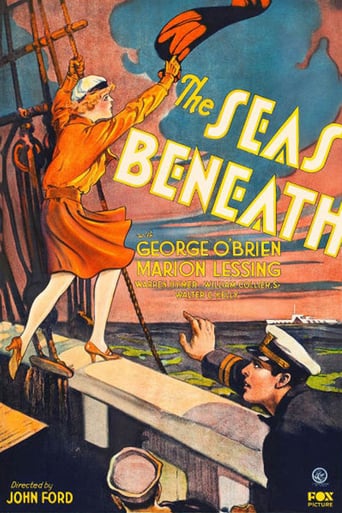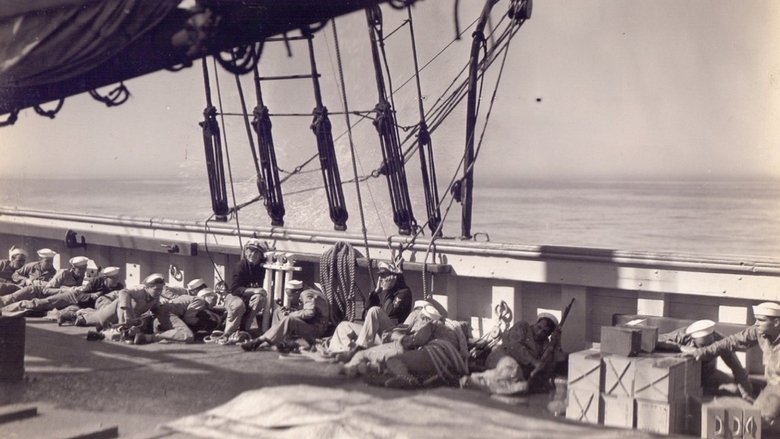

Seas Beneath (1931)
In the waning days of WWI, a U.S. "Mystery Ship," sets sail for the coast of Spain towing a submarine. Their mission is to find and sink a U-boat that has been especially effective in attacking Allied shipping. Posing as a harmless schooner, the mystery ship is in fact fitted with a formidable gun capable of sinking a U-boat. Stopping in the Canary Islands to refuel, the crew interacts with locals involved with Germans, and with Germans themselves, including the sister of the U-Boat commander, who is lurking offshore waiting for the coming battle.
Watch Trailer
Cast
Reviews
Really Surprised!
This is one of the few movies I've ever seen where the whole audience broke into spontaneous, loud applause a third of the way in.
Although I seem to have had higher expectations than I thought, the movie is super entertaining.
A terrific literary drama and character piece that shows how the process of creating art can be seen differently by those doing it and those looking at it from the outside.
In the oeuvre of John Ford his late silents are ahead of his early talkies in artistic aesthetics because of two important factors: actors and dialogue. While he is most known for his sagacious later period films like The Searchers or The Quiet Man (and many others) he has several excellent 20s films like 3 Bad Men and Four Sons (I still have not seen Iron Horse which I will have to rectify soon). Those silents work quite well on a visual level and have a surprising amount of movement sometimes analogous to a Murnau film. When sound became prominent many producers felt forced to exploit this aspect which slowed down movement, placed people in specific positions due to microphones and forced the focus to be more on verbal acting ability. The latter was the rub in Ford's early talkies.The biggest strength of this film is the look and feel of the settings and several nice shots of the camera. One of the biggest surprises is that most of this film is shot on location. There are beautiful shots on ships, on the sea and even some quick underwater shots (the earliest in a film I can think of) which show a submarine breaking the surface of the sea. John had the American naval at his disposal and it really showed. Given there is a possible anachronism of some of the equipment since this movie was supposed to take place during WWI.Then there is the rub. The sound is typical of early 30s with very little music, stifled acting with hammy delivery and a general slow plot.During WWI, a navel command is sending out a three-masted schooner in Spanish waters as a decoy (with a big hidden gun) to lure a famous U-Boat out of the water so it can possibly be torpedoed by a hidden American sub. When the navy personnel go ashore as merchants the captain falls in love with a double agent, while another personnel gets Mickeyed (sleeping potion) and left behind when the personnel cannot find him. The plot is mostly straightforward and the ending is obvious though still exciting. The Germans are treated (like in Grand Illusion) as humans so I do not think this played much in the 1940s.An interesting movie that will be fun for people who enjoy 1930s films as long as they can handle some of the flaws of plot and acting. John Ford's use of camera is quite evident but does not quite handle the plot and characters as well as in his later films.This movie can be found in the huge Fox at Ford box set.
Seas Beneath (1931) ** (out of 4) A U.S. "mystery ship" is sent out to destroy a German U-boat, which has been causing damage to Allied ships. Like many other early sound films, this one here suffers from non-stop talking, which is damaged because the dialogue is just downright stupid and bad. I guess studios would read screenplays and order additional dialogue because this film has so many subplots that I can't help but think they were added to boost up the dialogue. There's a love story between George O'Brien and Marion Lessing, which is just downright stupid and bad. I'm going to guess the relationship between the boat Commander and a possible German spy was meant to add suspense but it never does. Ford really seems bored with these various dialogue scenes because there's never an ounce of energy in them. What really works is the final twenty-minutes when the mystery ship goes up against the U-boat. There's a long sequence where the ship must fall under attack because the sub isn't in their range for a counter attack. This scene here is full of wonderful excitement and some real suspense. The action scenes are all very realistic and Ford really puts the viewer in a mind frame where it feels like you're actually on the ship. Outside of these scenes I'd have to say Ford's direction is pretty weak because it really seems like he's making a silent movie with dialogue. The scenes are really strange to look at and they never really feel like a director use to the sound technology.
I've been working my way through Ford at Fox, and found this to be the most entertaining of Ford's early talkies. After the joy of watching such silents as The Iorn Horse, 3 Bad Men, Four Sons and the Hangman's House, watching such talkies as Up The River and Born Reckless felt like I was paying my dues as a Ford fan.Seas Beneath was a real breath of fresh air. It plays out like the grand old silents where everything is staged for real. No models, no process shots. Want to shoot a scene at sea? Pack up the gear and go to sea.While the story has many of the hokey elements of early film melodramas, the scenes at sea are very real and very effective. You won't see better footage of a German submarine until Das Boot. And the scene where they unload the lifeboat onto the American ship: that was no water tank shot.While Seas Beneath pales in companion to Ford's great films from the 1930's, there is still much to admire in it.
I suspect that the poster from Oklahoma hasn't seen many other films from the early talkie era, because the pace and acting aren't bad for the times. What's most striking about this early Ford talkie is the location (shipboard) filming-- few films from the studio era make such a point of actually filming at sea instead of on a set in front of a sky backdrop. The vivid realism of these scenes is the most striking thing about the film today.


